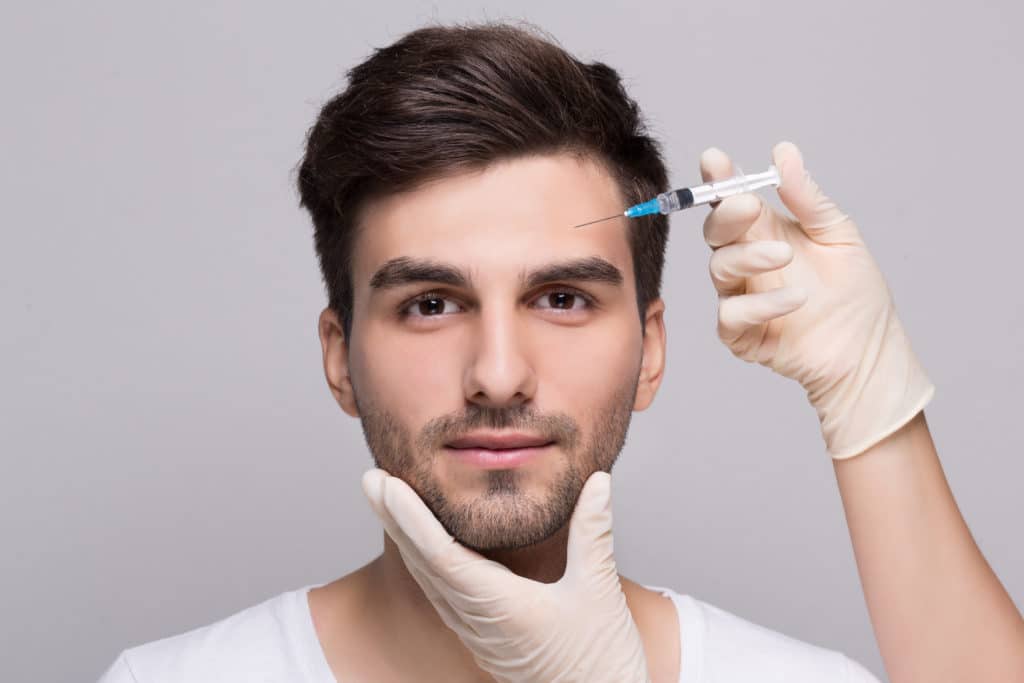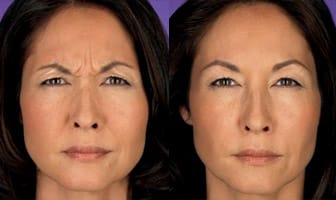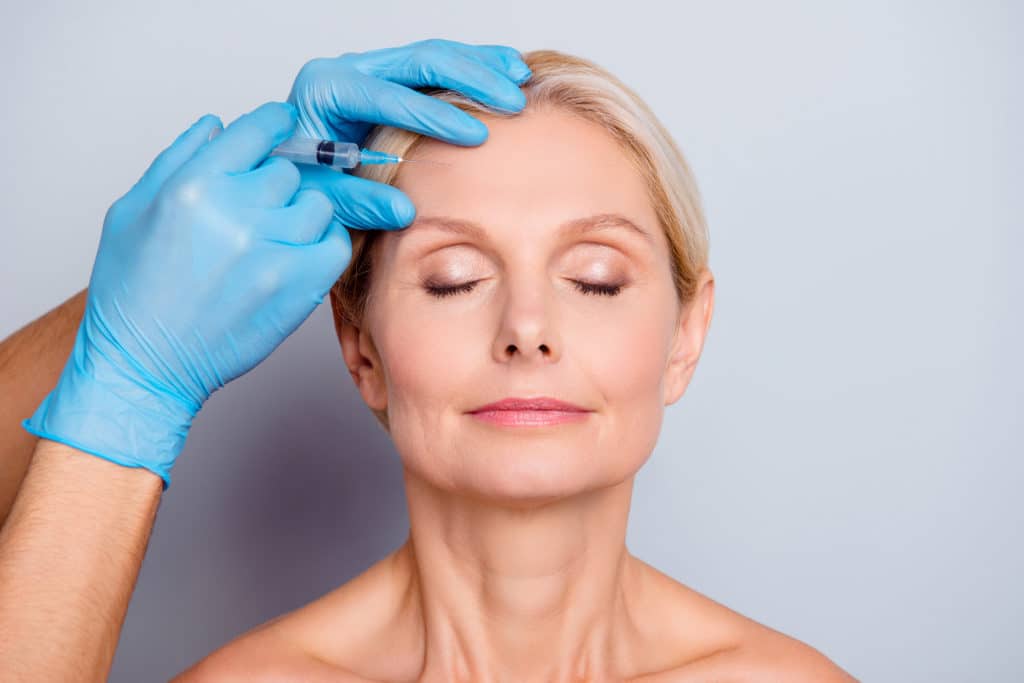BOTOX®
in Seattle & Bellevue, WA
Botox® is one of the world’s most well-known brand names, and it’s only been around for aesthetic use for less than 20 years. Why has Botox® become a worldwide phenomenon? Because it works. Botox® effectively erases wrinkles and lines on the upper third of the face for about four months.
Dr. Tarbet provides Botox® injections for her patients at her Bellevue practice.
What is Botox?
Botox® consists basically of the botulinum toxin type A. These are the same bacteria that cause botulism. That sounds scary, but it’s not. Back in the 1950s, scientists discovered that when the botulinum toxin was injected in very minute doses into a muscle it caused that muscle to stop contracting, to stay relaxed.
Botox® was developed directly from that research.
Botox® received its first FDA approval for the treatment of involuntary eyelid spasms in 1992. But when the FDA approved it for aesthetic use for treating crow’s feet and the like, things got a little crazy. Every year since that approval Botox® injections have been the world’s most popular cosmetic procedure, surgical and non-surgical.
How Does Botox Work?
Botox® works by blocking the nerve messages sent from a muscle to the brain. It blocks the acetylcholine transmitter that sends the message to the brain. The brain never receives the message to contract the muscle, so it stays relaxed. You can see how this would help with involuntary eyelid spasms.
It also helps prevent certain wrinkles from forming because they are caused by muscle contractions under the skin. These are known as dynamic wrinkles, and they form when we make common expressions such as showing surprise and frowning. Go ahead, make a frown and you’ll feel the muscles around your eyes, between your brows, and on your forehead contract. Over time, making these expressions thousands and thousands of times, wrinkles begin to form on the surface skin. These are crow’s feet around the eyes, the 11s between the brows, and forehead lines.
When Botox® is injected into the muscle that creates the wrinkle, it keeps the muscle from contracting, so the wrinkle on the surface skin is erased. That’s the magic of Botox® and why it has such a cult-like following.
Areas Treated With Botox
Botox® only works on dynamic wrinkles. That’s why the FDA approved it for use on the upper third of the face, the expressive area. Botox® erases crow’s feet on the sides of the eyes, the 11s between the eyebrows, and forehead lines and creases.
Who Is A Good Candidate for Botox?
As mentioned, Botox® works on the upper third of the face on dynamic wrinkles. There is another type of wrinkle, the static wrinkle. These form due to sun damage, declining collagen production, personal habits, and simple aging. Unlike dynamic wrinkles, static wrinkles have nothing to do with muscle movements; they are visible at all times. Static wrinkles form on the lower third of the face: marionette lines, smile lines, parentheses lines, and others. If you want to remove static wrinkles, Botox® is not the answer. Static wrinkles can be addressed with dermal fillers such as Juvéderm.
But if you have crow’s feet, the 11s, and lines on your forehead, then Botox® is a great solution.
What To Expect During Botox Injections
Botox® was deemed the original “lunchtime procedure” because it takes just 10-15 minutes for your injections. Dr. Tarbet handles all of her practice’s Botox® sessions because her extensive knowledge of facial anatomy and experience with this neuromodulator is important. She injects the Botox® with a very short, thin needle, and it is not injected to great depth. For that reason, patients don’t ask for topical numbing prior to their injections. They equate the feeling of each injection to that of a pinprick. Once your injections are complete, you can get right back to work or your other normal activities.
How Many Injections Will I Need?
Botox®, like all injectables, is priced by the unit. How much you use will be dictated on the areas you are addressing. Plus, there is some variance in how large and strong the patient’s targeted muscles are. Here are a couple rough guidelines.
- Glabellar lines (the 11s) usually take from 20-35 units of Botox®.
- Frontalis muscles that create forehead lines usually need from 6-20 units.
- Crow’s feet need from 6-15 units.
Recovery After Botox
There isn’t any recovery after having Dr. Tarbet inject your Botox®. But you must avoid rubbing the injection sites for 24 hours after your session. Doing so can make the Botox® migrate to an unwanted muscle, which can create issues such as a drooping eyelid.
The only after-effects are usually some slight redness and possible light swelling at the injection sites. This usually passes within a day.
After your injections, you can get right back to your normal day.
Botox Injection Results
Botox® will effectively erase your crow’s feet, glabellar lines, and forehead lines for a period of four months in most people. At that point, your body will absorb the now-inert Botox and the injected muscles will start to contract again. Another Botox® session with Dr. Tarbet will maintain your results.
Botox Vs. Dermal Fillers
Botox is classified as a neuromodulator, not a dermal filler. This is because it works on the dynamic wrinkles formed by muscle contractions. Botox has no effect on wrinkles caused by skin damage, i.e. static wrinkles.
Dermal fillers, such as Juvéderm® and Sculptra®, simply return volume to an area with a wrinkle, crease, or that has lost volume (sunken cheeks, for instance). Dermal fillers are true to their name — when injected beneath a crease or area of volume loss, they fill in the space, pushing the skin back upward. Dermal fillers work only on static wrinkles. Static wrinkles have nothing to do with muscle contractions; they are simply due to sun damage, declining collagen production, personal habits such as smoking, and other factors.
Dermal fillers don’t work on dynamic wrinkles, and neuromodulators don’t work on static wrinkles.
Alternatives to Botox
Schedule A Consultation
FAQ
What Are The Side Effects of BOTOX Cosmetic?
While BOTOX Cosmetic can help improve your facial features, there are potential side effects you need to be aware of. These side effects include bruising, redness, and swelling at the injection site.
Less common side effects can include:
- Headaches
- Flu-like symptoms
- Temporary muscle weakness
- Droopy eyelids
- Infection at the injection site
- Watery eyes
- Dry eyes
- Unwanted changes in your appearance
If you experience any of these side effects and they are not going away, contact Dr. Tarbet immediately.
Who Should Avoid BOTOX Cosmetic Injections?
Individuals who are allergic to the ingredients in BOTOX Cosmetic should avoid treatment. In addition, individuals with neurological diseases, such as MS or ALS, should avoid BOTOX Cosmetic treatment. Women who are currently pregnant or breastfeeding should not get BOTOX Cosmetic. If you are pregnant, it is best to wait until you are finished expanding your family to receive BOTOX Cosmetic, as well as any cosmetic procedure.
Do BOTOX Cosmetic Injections Hurt?
BOTOX Cosmetic injections are not designed to be painful. At most, you will feel a slight pinch when the injection is administered. Most patients tolerate BOTOX Cosmetic injections well, but for patients with low pain thresholds, a topical numbing cream can be applied to maximize comfort. Let your provider know if you prefer to have topical numbing before treatment. It is also best to let the doctor know if you do not like needles so they can make sure you feel safe and comfortable during treatment.
Is BOTOX Cosmetic Safe?
Due to the paralyzing nature of BOTOX Cosmetic, a lot of people wonder if it is safe. In most cases, receiving BOTOX Cosmetic treatment is generally safe when it is under the supervision of a licensed and skilled doctor. If someone is unqualified to administer BOTOX Cosmetic, there is a chance for unwanted results and complications. Always check the qualifications of a doctor before consulting with them about BOTOX Cosmetic injections.




